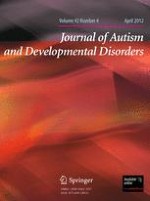01-04-2012 | Original Paper
Can Gaze Avoidance Explain Why Individuals with Asperger’s Syndrome Can’t Recognise Emotions From Facial Expressions?
Gepubliceerd in: Journal of Autism and Developmental Disorders | Uitgave 4/2012
Log in om toegang te krijgenAbstract
Research has shown that individuals with Autism Spectrum Disorders (ASD) have difficulties recognising emotions from facial expressions. Since eye contact is important for accurate emotion recognition, and individuals with ASD tend to avoid eye contact, this tendency for gaze aversion has been proposed as an explanation for the emotion recognition deficit. This explanation was investigated using a newly developed emotion and mental state recognition task. Individuals with Asperger’s Syndrome were less accurate at recognising emotions and mental states, but did not show evidence of gaze avoidance compared to individuals without Asperger’s Syndrome. This suggests that the way individuals with Asperger’s Syndrome look at faces cannot account for the difficulty they have recognising expressions.
